1. The Hot Universe
Of the largest structures in the Universe, groups and clusters of galaxies are the last to assemble into the more massive halos of matter. Their distributions in mass and space are extremely sensitive to the geometry of the Universe, and to its matter and energy content. The formation and evolution of these structures is a violent process. It leads to their gas content thermal heating to tens of millions of degrees, but also to the formation of shocks at all scales, generating gas motions, turbulence, and further convection, conduction, or viscosity further impacting the baryons thermodynamics and the process of the halo virialisation.
The formation of massive halos coincides with the peak of star formation in galaxies and maximal black hole activity. Beyond its radiative cooling through its gravitational fall, their hot gas content is further affected by the feedback from galaxies evolution. This happens via supernova-generated winds or the activity of supermassive black holes (SMBH) at the centre of galaxies. These processes prevent the excessive cooling of the gas at the centre of the clusters, they regulate the formation of stars in member galaxies and the activity of their central SMBH. They also ensure the chemical enrichment of the intra-cluster medium, the plasma within galaxy clusters.
Groups and clusters of galaxies are fed with matter by their surrounding cosmic web in which most baryons lie as a tenuous diffuse warm gas. This elusive warm-hot intergalactic medium (WHIM) holds the key to the missing baryon problem in the local Universe. Its thermodynamical state and chemical composition also bear the physical imprint of early galaxy formation and evolution.
The study of the population of groups, clusters of galaxies, and of the WHIM is therefore the path to our understanding of the assembly of structures and their hot baryons content, hence of what we call the Hot Universe.
Galaxy cluster bulk motions and turbulences
Clusters of galaxies are constituted of galaxies, hot gas, and dark matter. They assemble via successive mergers and continuous accretion of matter from their surroundings. In the case of galaxy cluster assembly and evolution through gravitational infall and merging, sub-cluster velocities can reach 2000 km/s and the merging process can release gravitational binding energies greater than 10^64 erg. This drives shocks into the intra-cluster medium (ICM) and generates bulk motions and turbulence in the gas, that can persist for more than a billion years. The turbulence cascades down to smaller scales where it is dissipated, thus contributing to the heating and virialisation of the ICM.
Turbulence can also be induced by the activity of supermassive black holes hosted in the largest galaxies at the centre of groups and clusters. Their jets and outburst are able to move matter and transport energy over scales of a few hundred kpc with time. This process tidily links the supermassive black hole, its host galaxy, and the surrounding gaseous atmosphere, and it is a key element to the thermodynamics of the core of groups and clusters of galaxies.
High-resolution X-ray spectroscopy with the X-IFU will allow the direct detection of bulk and turbulent motions in the ICM plasma through measurement of the shifting and broadening, respectively, of emission lines. Its thousands of detectors will allow the mapping of the line-of-sight bulk and turbulent velocity field of the ICM plasma in many galaxy clusters on unprecedented spatial scales. The ability to resolve emission line complexes (e.g., Iron around 6.7 keV) and measure line ratios will further constrain the thermodynamics and ionisation state of the gas far out into the cluster outskirts.
X-IFU will allow us to link the bulk and turbulent motions directly to the cluster assembly process, and better understand how the baryonic matter assembles and evolves in the dark matter potential.
- Associated Mission Design Science Objective (MDSO) : “Constrain the kinematics of hot gas and metals in massive haloes”
Chemical enrichment of the Universe
Most chemical elements required for the existence of life are the result of stellar evolution. Through the powerful action of supernovae and supermassive black holes, a large fraction of the stars’ chemical elements escaped the galaxy in which they were formed. They now reside in the circumgalactic, intergalactic and intra-cluster medium, where their emission lines can be observed through X-ray spectroscopy. This process is the chemical enrichment of the Universe.
The chemical composition of the hot gaseous atmosphere of groups and clusters of galaxies encodes the mixed metal production by core-collapse and type-Ia supernovae, as well as asymptotic giant branch stars over cosmic time. The X-IFU’s exquisite sensitivity to weak emission lines will double the number of chemical elements that can be routinely measured in nearby galaxy clusters. This will reveal important information about the progenitors and explosion mechanisms of different supernova types, as well as the metallicity and initial mass function of the stars responsible for the enrichment.
Recent studies suggest that most chemical elements were injected into the intra-cluster medium when the Universe was less than half its present age. Only the NewAthena telescope’s large effective area, together with the 2.5 eV spectral resolution of the X-IFU, will provide the unprecedented sensitivity needed to probe the chemical composition of the earliest clusters and proto-clusters, in order to understand exactly how and when this enrichment took place.
We also do not know in detail how chemical elements are redistributed as a consequence of stellar and supermassive black hole feedback. The X-IFU will measure the chemical composition in X-ray faint halos of much lower mass than accessible today and out to the epoch of the formation of groups and clusters of galaxies, where these feedback processes have a larger impact. In addition, the capabilities of the X-IFU will allow detailed spatial mapping of the distribution and velocities of various chemical elements, in order to deliver new insight into the feedback physics that is a crucial ingredient of modern galaxy formation models.
- Associated Mission Design Science Objective (MDSO) : “Chemical enrichment over cosmic time”
Active galactic nuclei (AGN) feedback
Active galactic nuclei (AGN) are regions at the centres of galaxy groups and clusters with very high luminosity. They play a critical role in shaping the properties of the central galaxy and the surrounding intra-cluster medium.
Mechanical feedback from AGN jets is thought to be one of the best candidates explaining the suppression of star formation in the massive central galaxies and the heating of the gas inside and beyond the cluster core.
The existence of feedback from AGN jets is supported by observations of X-ray cavities surrounding the radio lobes that form around some galaxies. In the centre of bright, nearby clusters, X-IFU’s measurements of the X-ray emission line profiles and variations of the line position will allow the estimation of the characteristic spatial scales of the turbulent motions. These are induced by AGN jets on scales of tens of kiloparsec, and mapping of the velocity field of the hot gas to an accuracy of approximately 20 km/s.
This will give unprecedented insights into how power from the initially highly-collimated jets is distributed into the surrounding intra-cluster medium. The thermal and non-thermal energy content of the X-ray cavities will be measured accurately for the first time, helping to establish their composition. X-IFU will help to directly detect the shocked gas surrounding expanding radio lobes. Its spectral resolution will be sufficient to assess shock expansion speeds for the first time. The dynamics of the hot gas around nebula of cool and molecular gas filaments, found around central galaxies, will yield essential clues to increase our understanding of the entire cycle of heating and cooling in the cores of nearby clusters and groups. Robust jet power measurements for large samples can be compared to accretion rates of hot and cold material, enabling insights into the accretion process and black hole growth.
- Associated Mission Design Science Objective (MDSO) : “Constrain the kinematics of hot gas and metals in massive haloes”
The Warm-Hot Intergalactic Medium (WHIM) and the missing baryons
According to hydro-dynamical simulations for the production of structures in the Universe, the local plasma between galaxies is populated with hot baryons with temperatures of about 1 million degrees, the “Warm-Hot Intergalactic Medium” (WHIM). At these temperatures, the WHIM is highly ionized, with only one neutral atom of hydrogen out of ten million, and thus invisible to optical and infrared observations. The only tracers of this important and still elusive baryonic component of the Universe are highly ionized metals.
Metals are produced in galaxies and then ejected out to their surroundings through powerful stellar and active galactic nuclei winds. Such metals are expected to imprint many absorption (and emission) lines in high-resolution soft X-ray spectra of background quasars and Gamma Ray Bursts. The strongest of these lines are imprinted by the innermost parts of the circumgalactic medium (CGM) of large and rare intervening halos. Weaker and more common lines are produced by the galaxy’s CGMs and the tenuous filaments of the intergalactic web that connect them. Altogether they form the WHIM absorbers.
X-IFU’s superb spectral resolution, and NewAthena’s unprecedented mirror collective area, will be a unique machinery to finally detect and characterize the Universe’s missing baryonic mass in the WHIM. It will also shed light on the associations between highly-ionized metals in the WHIM and the galaxies responsible for their production. This, in turn, will greatly improve our understanding of the continuous feedback process governing the co-evolution of galaxies and the intergalactic medium throughout cosmic time.
NewAthena will enable the detection and separation (in velocity space) of multiple WHIM absorbers along a single line of sight. It will also enable their physical characterization (temperature) and unambiguous associations with the nearby halos responsible for the very production of the detected metals (e.g. Figure 1).
- Associated Mission Design Science Objective (MDSO) : “Map via deep X-ray spectroscopy the properties of the most common baryonic reservoirs in the Universe, and probe their evolution and connection to the cosmic web”



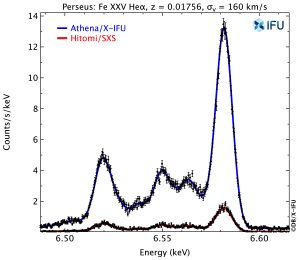
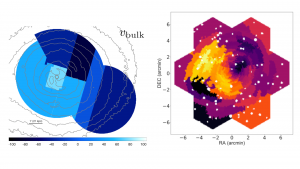
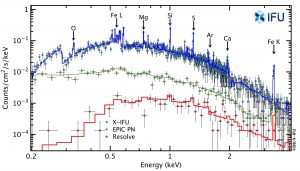
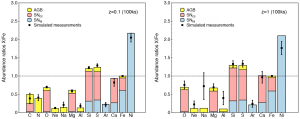
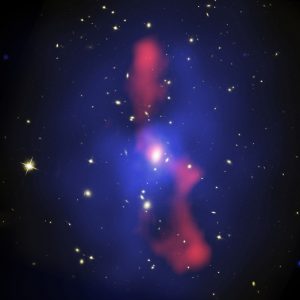
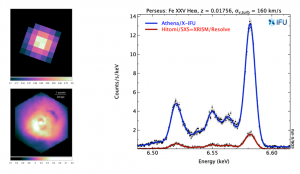
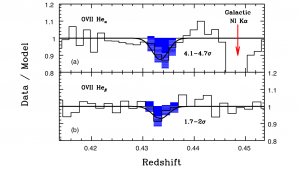

 Youtube
Youtube